KTiOPO4(KTP)
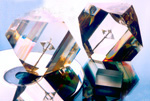 KTP (KTiOPO4) is a nonlinear optical crystal, which possesses excellent nonlinear and electro-optic properties.It has large nonlinear optical coefficients and wide angular bandwidth and small walk-off angle,etc.which make it suitable for various nonlinear frequency conversion and wave guide application. Due to very high effective nonlinearity (d eff ~8.3xd 36 (KDP)at 1.06 µm) and excellent optical properties,KTP perfectly suits as lasing material in various applications .The phase matching range of KTP crystal lies in 0.99-3.3 µm region .This allows us to use KTP as an intracavity and extracavity frequency double for the most commonly used lasers,such as Nd:YAG,Nd:Glass and Nd:YLF.
KTP (KTiOPO4) is a nonlinear optical crystal, which possesses excellent nonlinear and electro-optic properties.It has large nonlinear optical coefficients and wide angular bandwidth and small walk-off angle,etc.which make it suitable for various nonlinear frequency conversion and wave guide application. Due to very high effective nonlinearity (d eff ~8.3xd 36 (KDP)at 1.06 µm) and excellent optical properties,KTP perfectly suits as lasing material in various applications .The phase matching range of KTP crystal lies in 0.99-3.3 µm region .This allows us to use KTP as an intracavity and extracavity frequency double for the most commonly used lasers,such as Nd:YAG,Nd:Glass and Nd:YLF.
Physical and Optical Properties
Crystal structure: .................................................. Orthorhombic, point group mm 2
Melting point: ..........................................................................1172°C incongruent
Cell parameters: ......................................... a=6.404Å, b=10.616Å, c=12.814Å, Z=8
Curie point: ...................................................................................................936°C
Mohs hardness:................................................................................................... ~5
Density: .................................................................................................3.01 g/cm 3
Color: ......................................................................................................... colorless
Hygroscopic susceptibility:.................................................................................... no
Specific heat: ................................................................................. 0.1643 cal/g.°C
Thermal conductivity: ........................................................................0.13 W/cm/°K
Electrical conductivity: .....................................3.5x10 -8 s/cm (c-axis, 22°C, 1KHz)
Transmitting range: .......................................................................350nm~4500nm
Refractive indices: .............................nx=1.7377, ny=1.7453, nz=1.8297@1064nm
..............................nx=1.7780, ny=1.7886, nz=1.8887@1064nm Absorption coefficients: .................................a < 1%/cm @1.064 µm and 0.532 µm
Phase matchable range: ...................................................................0.984 - 3.4 µm
Therm-optic coefficients:
..............................dnx/dT=1.1x10-5/°C, dny/dT=1.3x10-5/°C, dnz/dT=1.6x10-5/°C
Nonlinear optical coefficients (pm/V):
...........................d31=2.54, d31=4.35, d31=16.9 d24=3.64, d15=1.91 @
d eff (II) ≈ (d 24 - d 15 )sin
Electro-optic coefficients:
Low Frequency (pm/V):......... r 13=9.5, r 23=15.7, r 33=36.3, r 51=7.3, r42=9.3
High Frequency (pm/V):........................r 13=8.8, r 23=13.8, r 33=35.0, r 51=6.9
Different coating specification upon customer request.
1)Angle tolerance: ..........................................................Δθ < ± 0.5°; Δφ < ± 0.5°
2)Dimension tolerance: ...........(W ± 0.1mm) x (H ± 0.1mm) x (L + 0.2mm/-0.1mm)
3)Flatness: ..........................................................................................λ/8 @ 633nm
4)Scratch/Dig code: .......................better than 10/5 Scracth/dig per MIL-O-13830A
5)Parallelism: ................................................................................< 20 arc seconds
6)Perpendicularity:...........................................................................< 5 arc minutes
7)Wavefront distortion:....................................................................< λ/8 @ 633nm
8)Clear aperture:.......................................................................> 90% central area
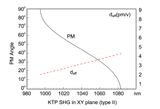
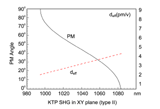
Fig.1 Fig.2
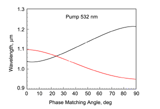
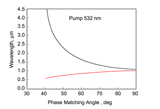
Fig.3 Fig.4
Sellmeier equations: ................n x 2 =3.0065+0.03901/( l 2 -0.04251)-0.01327 l 2
n y 2 =3.0333+0.04154/( l 2 -0.04547)-0.01408 l 2
n z 2 =3.3134+0.05694/( l 2 -0.05658)-0.01682 l 2
Capabilities
1)Aperture: .....................................................................................1x1 ~ 10x10mm
2)Length: ............................................................................................0.05 ~ 20mm
3)Phase Matching Angle:
Determined by different homonic generartion typical θ=90°; φ=23.5° for SHG 1064nm
4)Phase matching type: .................................................................................Type II
5)Typical Coating:
a) S1&S2: AR @1064nm R<0.1%; AR @ 532nm, R<0.25%.
b) S1: HR @1064nm, R>99.8%; HT @808nm, T>5%


